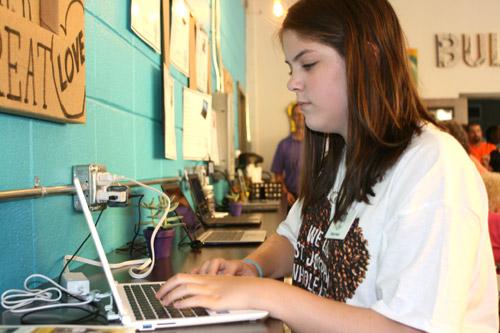

Parents can remember when they were in school their teacher writing the day’s assignment on the chalkboard. They would then go home, complete their assignment on paper and turn it in the next day … of course walking to school uphill both ways.
Their children’s educational experience is vastly different. The teacher now has the ability to e-mail an assignment to students, which they can complete on their Google Chromebooks (similar to laptops, but all the information is stored on the web rather than the device itself). Or, cutting out e-mail, a project can be created on a Google app and the students and teacher can interact in real-time.
“Our schools are working toward implementing a lot of computer programs,” said Catholic schools superintendent Vernell Bowen. “I think it’s great, very progressive.”
St. Joseph School in Conway and Christ the King School in Little Rock have jumped into this phenomenon using Google.
Google Apps for Education is an online program free for schools that use Google apps, such as Google Docs, Gmail and Google Calendar, to provide a more streamlined communication environment between students and the teacher and between teachers, while also allowing the children to learn how to use technology for assignments and research. Some of the benefits Google touts is no advertisements on the apps, 24/7 free tech support, uptime 99.9 percent of the time and that the apps can work on any computer, tablet or smartphone. It is up to each teacher which apps to use in their classrooms.
St. Joseph School has been using the Google Apps for Education platform for three years.
“They were going from the century they live in back to the dinosaur age,” said middle school principal Susie Freyaldenhoven before Google Apps for Education. “We need to find a balance; not completely saying don’t bring your devices, but bring your devices to use for instruction, not just for play.”
The Google domain is $12 a year, instead of thousands spent on Microsoft servers and software updates, she said. Wi-Fi is also required.
Students can also access their school documents from anywhere.
“You can’t come back to school and say ‘the dog ate my homework,’” Freyaldenhoven said. Though 11-year-old Jacob Williams quipped to Arkansas Catholic, the new excuses are “my battery was dead or the Internet was out.”
The school is equipped with 30 iPads, primarily for kindergarten through second grade, and 100-plus Chromebooks for third through 12th grade.
Emily Hambuchen, 15, said the program gives her and other students a variety of new ways to learn.
“My favorite aspect is not having to carry a lot of books, it’s all in the drive,” the 10th-grader said. “It’s a lot different, but if you keep an open mind, it will be great.”
For teachers who are skeptical of the new technology, English teacher Kathleen Gueringer said the first step is admitting that.
“Admit that you don’t know everything,” Gueringer said, adding that it’s important be open to learning about technology from the students. “We’re learning how to do this together.”
This year, St. Joseph has asked all parents with fourth-grade students to buy their own Chromebooks, which cost around $200. The school will have rentals for families that cannot afford it, Freyaldenhoven said.
Administrators can monitor the students’ Internet usage, from controlling their e-mail account to seeing what has been revised on a Google document.
St. Joseph after-school program director Laura Williams, who has six children at the school including Jacob Williams, said, “I love it. I was really able to see the power of what (technology) can do.”
At Christ the King, they are “baby stepping” into the program with fifth- and sixth-graders this year. The school spent $17,000 on 30 Chromebooks for students, six for teachers and a rechargeable cart, said principal Kathy House.
While attending a Google Summit last spring, House and assistant principal Paige Coppola took part in a Google class simulation. House said after watching a YouTube video on earthquakes on their Chromebooks, they could type questions in a document on Google Docs. A simple right click on the question showed a drop down menu that had the option of “research.”
“The answer popped up right there on the computer screen,” House said.
She then was able to make a slideshow that was immediately transferred to the instructors Smartboard and presented to the class.
“He totally drove the lesson,” House said, explaining Google Apps is not a replacement for the teacher but rather a tool to help educate students.
While widespread acceptance of a technology education program might be awhile off, Freyaldenhoven said it will be the future.
“At some point it’ll grow into other schools. That’s just the world we live in,” Freyaldenhoven said.
Please read our Comments Policy before posting.
Article comments powered by Disqus Papineau steps back after 20 years in parochial league
Papineau steps back after 20 years in parochial league
 2023 Year in Review: Community, teamwork prove pivotal
2023 Year in Review: Community, teamwork prove pivotal
 Bishop Taylor decommissions Fayetteville college church
Bishop Taylor decommissions Fayetteville college church
 Catholic school careers lead teachers, staff into faith
Catholic school careers lead teachers, staff into faith
 Off-duty officers patrol Christ the King in Fort Smith
Off-duty officers patrol Christ the King in Fort Smith
 Winning directory photo honors Our Lady of Guadalupe
Winning directory photo honors Our Lady of Guadalupe
 St. Paul says: How does the Bible define love?
St. Paul says: How does the Bible define love?
 6 steps to getting married in Diocese of Little Rock
6 steps to getting married in Diocese of Little Rock
 Most frequently asked questions on Catholic marriage
Most frequently asked questions on Catholic marriage
 St. Joseph a model of solidarity with immigrants
St. Joseph a model of solidarity with immigrants
 Two gifts after Jesus’ death: Virgin Mary and Eucharist
Two gifts after Jesus’ death: Virgin Mary and Eucharist
 Why we have an altar, and not just a communion table
Why we have an altar, and not just a communion table
 Pope: Wars should be resolved through nonviolence
Pope: Wars should be resolved through nonviolence
 Living relationship with Jesus Christ in the Eucharist
Living relationship with Jesus Christ in the Eucharist